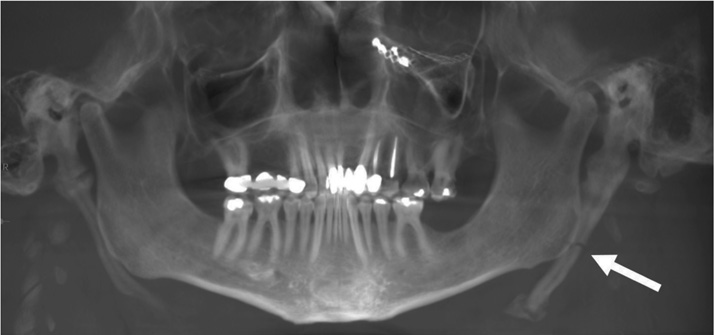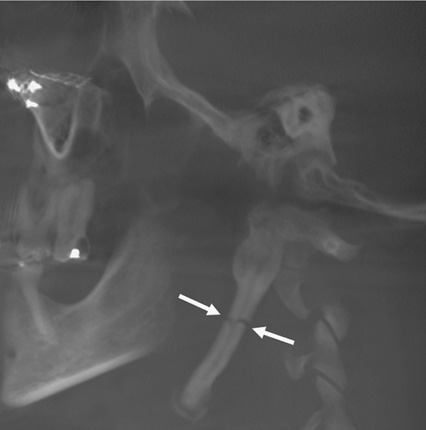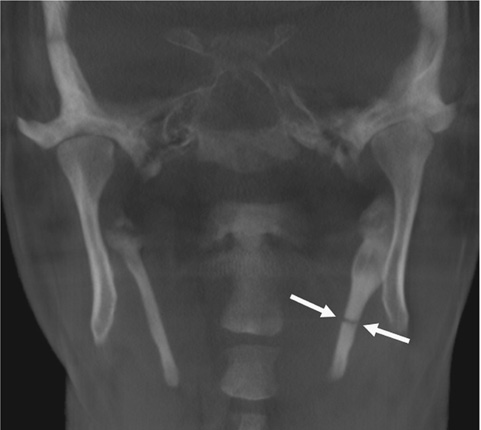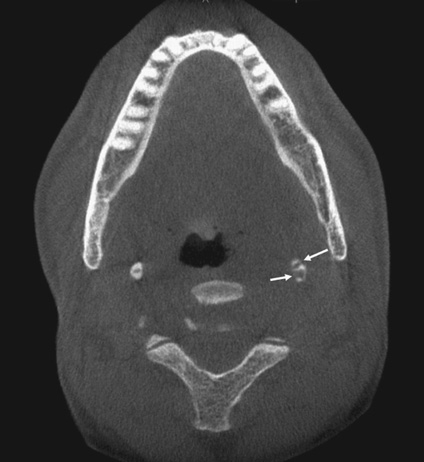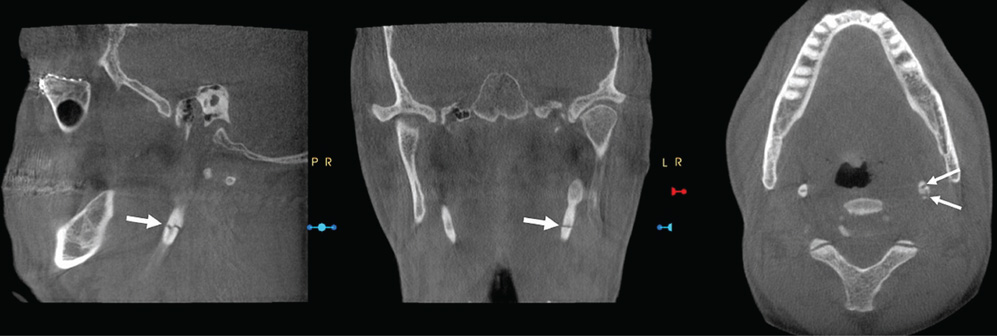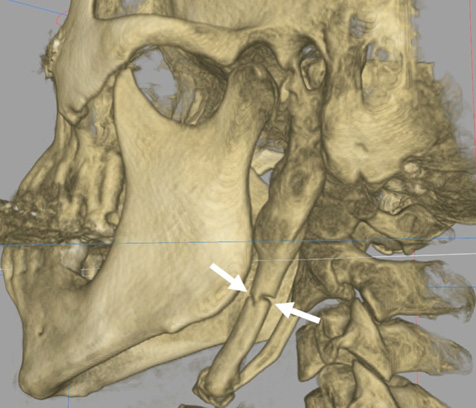Imaging Sci Dent.
2018 Mar;48(1):67-72. 10.5624/isd.2018.48.1.67.
Fractured styloid process masquerading as neck pain: Cone-beam computed tomography investigation and review of the literature
- Affiliations
-
- 1Division of Radiology, Department of Oral Medicine, University of Pennsylvania School of Dental Medicine, Philadelphia, PA, USA. mmd@upenn.com
- 2Division of Growth and Development, Section of Orthodontics, School of Dentistry, University of California, Los Angeles, Los Angeles, CA, USA.
- 3Department of Oral and Maxillofacial Surgery, School of Dentistry, Virginia Commonwealth University, Richmond, VA, USA.
- KMID: 2406985
- DOI: http://doi.org/10.5624/isd.2018.48.1.67
Abstract
- Historically, Eagle syndrome is a term that has been used to describe radiating pain in the orofacial region, foreign body sensation, and/or dysphagia due to a unilateral or bilateral elongated styloid process impinging upon the tonsillar region. Because elongated styloid processes-with or without associated Eagle syndrome-can present with various symptoms and radiographic findings, it can be challenging for healthcare practitioners to formulate an accurate diagnosis. Abnormal styloid anatomy can lead to a multitude of symptoms, including chronic orofacial/neck pain, thus masquerading as more commonly diagnosed conditions. In this report, we describe a patient who presented to our department with styloid process elongation and fracture. A careful history, physical examination, and a conebeam computed tomography (CBCT) investigation led to the diagnosis. The patient was then referred for appropriate care. This case report demonstrates the utilization of CBCT in differentiating a fracture site from a pseudo-joint that might mimic a fracture.
Keyword
MeSH Terms
Figure
Reference
-
1. Rechtweg JS, Wax MK. Eagle's syndrome: a review. Am J Otolaryngol. 1998; 19:316–321.
Article2. Naik SM, Naik SS. Tonsillo-styloidectomy for Eagle's syndrome: a review of 15 cases in KVG Medical College Sullia. Oman Med J. 2011; 26:122–126.3. Mupparapu M, Robinson MD. The mineralized and elongated styloid process: a review of current diagnostic criteria and evaluation strategies. Gen Dent. 2005; 53:54–59.4. Feldman VB. Eagle's syndrome: a case of symptomatic calcification of the stylohyoid ligaments. J Can Chiropr Assoc. 2003; 47:21–27.5. Han MK, Kim DW, Yang JY. Non surgical treatment of Eagle's syndrome - a case report -. Korean J Pain. 2013; 26:169–172.
Article6. Politi M, Toro C, Tenani G. A rare cause for cervical pain: Eagle's syndrome. Int J Dent. 2009; 2009:781297.
Article7. Chandler JR. Anatomical variations of the stylohyoid complex and clinical significance. Laryngoscope. 1977; 87:1692–1701.8. Murtagh RD, Caracciolo JT, Fernandez G. CT findings associated with Eagle syndrome. AJNR Am J Neuroradiol. 2001; 22:1401–1402.9. Gokce C, Sisman Y, Sipahioglu M. Styloid process elongation or Eagle's syndrome: is there any role for ectopic calcification? Eur J Dent. 2008; 2:224–228.
Article10. Eagle WW. Symptomatic elongated styloid process: report of two cases of styloid process-carotid artery syndrome with operation. Arch Otolaryngol. 1949; 49:490–503.
Article11. Eagle WW. Elongated styloid process: report of two cases. Arch Otolaryngol. 1937; 25:584–587.12. Eagle WW. Elongated styloid process; symptoms and treatment. AMA Arch Otolaryngol. 1958; 67:172–176.
Article13. Balbuena L Jr, Hayes D, Ramirez SG, Johnson R. Eagle's syndrome (elongated styloid process). South Med J. 1997; 90:331–334.
Article14. Langlais RP, Miles DA, Van Dis ML. Elongated and mineralized stylohyoid ligament complex: a proposed classification and report of a case of Eagle's syndrome. Oral Surg Oral Med Oral Pathol. 1986; 61:527–532.
Article15. Mendelsohn AH, Berke GS, Chhetri DK. Heterogeneity in the clinical presentation of Eagle's syndrome. Otolaryngol Head Neck Surg. 2006; 134:389–393.
Article16. Balasubramanian S. The ossification of styloid ligament and its relation to facial pain. Br Dent J. 1964; 116:108–111.17. Khandelwal S, Hada YS, Harsh A. Eagle's syndrome - a case report and review of the literature. Saudi Dent J. 2011; 23:211–215.
Article18. Keur JJ, Campbell JP, McCarthy JF, Ralph WJ. The clinical significance of the elongated styloid process. Oral Surg Oral Med Oral Pathol. 1986; 61:399–404.
Article19. Tiwary P, Sahoo N, Thakral A, Ranjan U. Styloid process fracture associated with maxillofacial trauma: incidence, distribution, and management. J Oral Maxillofac Surg. 2017; 75:2177–2182.
Article20. Pinheiro TG, Soares VY, Ferreira DB, Raymundo IT, Nascimento LA, Oliveira CA. Eagle's syndrome. Int Arch Otorhinolaryngol. 2013; 17:347–350.
Article21. Gossman JR Jr, Tarsitano JJ. The styloid-stylohyoid syndrome. J Oral Surg. 1977; 35:555–560.22. Alcalde RE, Ueyama Y, Nishiyama A, Mizuguchi T, Matsumura T, Kishi K. Diagnostic imaging of Eagle's syndrome: report of three cases. Oral Radiol. 1994; 10:63–68.
Article23. Kermani H, Dehghani N, Aghdashi F, Esmaeelinejad M. Nonsyndromic isolated temporal bone styloid process fracture. Trauma Mon. 2016; 21:e24395.
Article24. Gayathri G, Elavenil P, Sasikala B, Pathumai M, Krishnakumar Raja VB. ‘Stylo-mandibular complex’ fracture from a maxillofacial surgeon's perspective-review of the literature and proposal of a management algorithm. Int J Oral Maxillofac Surg. 2016; 45:297–303.25. Dubey KN, Bajaj A, Kumar I. Fracture of the styloid process associated with the mandible fracture. Contemp Clin Dent. 2013; 4:116–118.
Article26. Blythe JN, Matthews NS, Connor S. Eagle's syndrome after fracture of the elongated styloid process. Br J Oral Maxillofac Surg. 2009; 47:233–235.
Article27. Smith GR, Cherry JE. Traumatic Eagle's syndrome: report of a case and review of the literature. J Oral Maxillofac Surg. 1988; 46:606–609.
Article28. Chase DC, Zarmen A, Bigelow WC, McCoy JM. Eagle's syndrome: a comparison of intraoral versus extraoral surgical approaches. Oral Surg Oral Med Oral Pathol. 1986; 62:625–629.
Article29. Chrcanovic BR, Custódio AL, de Oliveira DR. An intraoral surgical approach to the styloid process in Eagle's syndrome. Oral Maxillofac Surg. 2009; 13:145–151.
Article30. Strauss M, Zohar Y, Laurian N. Elongated styloid process syndrome: intraoral versus external approach for styloid surgery. Laryngoscope. 1985; 95:976–979.31. Baseer MA, Alenazy MS. Eagle's syndrome: a rare case of young female. Dent Res J (Isfahan). 2013; 10:568–570.32. Mayrink G, Figueiredo EP, Sato FR, Moreira RW. Cervicofacial pain associated with Eagle's syndrome misdiagnosed as trigeminal neuralgia. Oral Maxillofac Surg. 2012; 16:207–210.
Article
- Full Text Links
- Actions
-
Cited
- CITED
-
- Close
- Share
- Similar articles
-
- Three-dimensional imaging modalities in endodontics
- Management of root canal perforation by using cone-beam computed tomography
- Isolated tympanic plate fracture detected by cone-beam computed tomography: report of four cases with review of literature
- Cone beam CT findings of retromolar canals: Report of cases and literature review
- Cervico-stylo-mandibular complex fracture: a critical review of literature along with a protocol to recognize and proposal of a new classification

